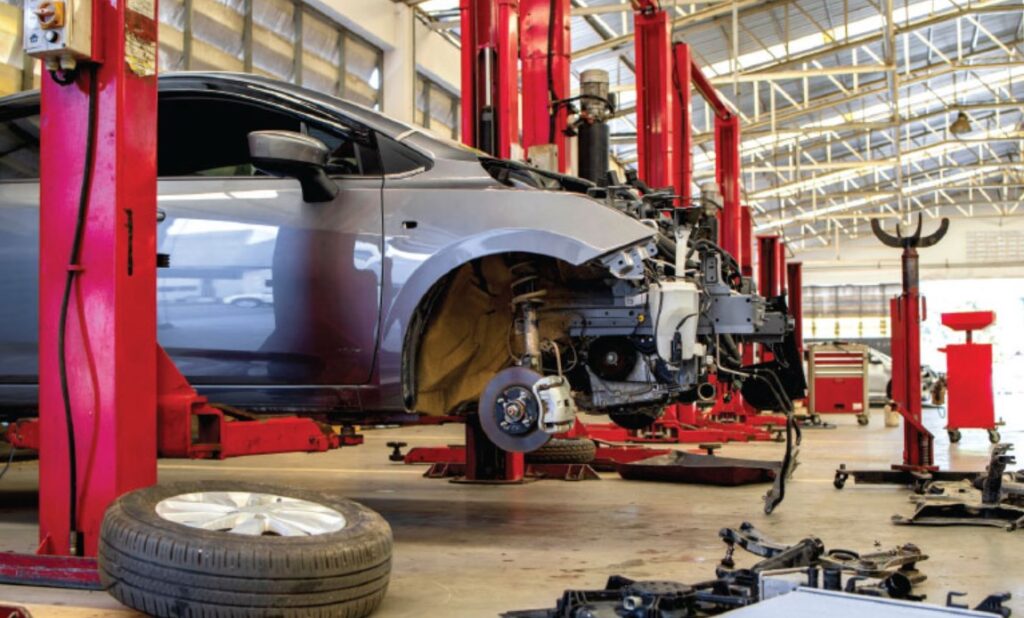This article aims to provide information on How To Lower Commercial Auto Insurance? In today’s dynamic business landscape, managing expenses is crucial, especially when it comes to commercial auto insurance. High insurance premiums can significantly impact your financial health. Understanding how to lower commercial auto insurance is vital for businesses seeking financial stability and growth.
Key Takeaways
- Assess Coverage Needs: Regularly review and adjust your insurance coverage to fit your current business needs.
- Increase Deductibles: Opt for higher deductibles to reduce premium costs.
- Promote Safe Driving: Implement a safe driving program to minimize risks and accidents.
- Bundle Policies: Combine multiple insurance policies for discounts.
- Regularly Review and Compare Quotes: Periodically check for better insurance rates and coverage options.
- Leverage Technology: Utilize telematics and other technologies to monitor driving behavior and reduce risks.
How To Lower Commercial Auto Insurance?
Lowering commercial auto insurance involves a multifaceted approach, each step targeting a different aspect of your insurance costs. Here’s a detailed breakdown of each step:

Assess and Adjust Coverage Needs
- Regularly review your insurance policy to ensure it aligns with your current business operations.
- Adjust coverage limits based on the scale of your operations, the number and type of vehicles, and the level of risk involved.
- Opt out of unnecessary coverages that don’t align with your risk profile or business requirements.
Increase Deductibles
- Opt for higher deductibles to lower your premium costs.
- Analyze your financial capacity to handle out-of-pocket expenses in the event of a claim.
- Balance the deductible amount with your business’s ability to absorb potential losses.
Implement Safe Driving Programs
- Develop and enforce a safe driving policy within your organization.
- Offer defensive driving courses and regular training sessions for your drivers.
- Monitor driving habits and maintain strict standards for road safety.
Bundle Insurance Policies
- Combine multiple insurance policies with the same provider.
- Look for bundling options that offer discounts for having several policies, like combining commercial auto insurance with general liability or property insurance.
Regularly Review and Compare Insurance Quotes
- Periodically check the market for insurance quotes from different providers.
- Evaluate the cost and coverage options and compare them with your current policy.
- Keep an eye out for new offerings or discounts in the market.
Leverage Technology for Safety
- Utilize telematics to monitor driving behavior and vehicle usage.
- Invest in vehicles equipped with safety features like GPS tracking, collision avoidance systems, and dash cams.
- Use the data from these technologies to negotiate lower premiums based on reduced risk.
Maintain Vehicles Regularly
- Keep your fleet in top condition through regular maintenance.
- Address mechanical issues promptly to prevent accidents and breakdowns.
- Update your fleet with newer, safer vehicle models when feasible.
Manage Risks Effectively
- Conduct regular risk assessments to identify and mitigate potential hazards.
- Create a risk management plan that includes strategies for reducing the likelihood of accidents and claims.
- Tailor your insurance policy to address the specific risks identified in the assessment.
Build a Strong Relationship with Your Insurer
- Maintain open communication with your insurance provider.
- Discuss ways to lower your premiums while maintaining adequate coverage.
- Leverage a good track record of safety and low claims to negotiate better terms.
Employee Screening and Management
- Conduct thorough background checks on employees who will be driving company vehicles.
- Monitor and manage driver performance to ensure adherence to safety standards.
- Recognize and reward safe driving practices within the company.
Understanding Commercial Auto Insurance

What is Commercial Auto Insurance?
Commercial auto insurance safeguards businesses against financial losses stemming from accidents involving company vehicles. It encompasses liability coverage for property damage and injuries, collision coverage, and comprehensive insurance for damage from non-collision events. Tailoring this insurance to your business needs is crucial for optimal protection and cost efficiency.
The Importance of Customized Coverage
Customizing your commercial auto insurance policy ensures that it aligns with your specific business requirements. Over-insuring leads to unnecessary expenses, while under-insuring risks significant financial loss. Regular policy reviews and adjustments are essential to maintain the right balance.
Strategies to Reduce Premiums
Opting for Higher Deductibles
A higher deductible results in lower premiums. Choosing a deductible that your business can comfortably afford in case of a claim is a practical strategy to manage insurance costs. However, it’s important to balance the deductible with your business’s financial capability to handle potential claims.
Implementing Safe Driving Programs
Safe driving programs can substantially reduce the risk of accidents, which in turn can lower insurance premiums. These programs should focus on driver training, regular vehicle maintenance, and adherence to safety regulations. A strong safety record is often rewarded with lower insurance rates.
Bundle Insurance Policies
Bundling multiple insurance policies with the same provider can lead to significant savings. Many insurers offer discounts for combining commercial auto insurance with other business insurance policies, such as property or liability insurance. This approach not only reduces costs but also simplifies policy management.
Using Technology to Your Advantage
Telematics and Risk Management
Telematics technology, which monitors driving behavior and vehicle usage, is increasingly popular in managing commercial auto insurance costs. It provides valuable data that can be used to improve driver safety, optimize vehicle usage, and potentially lower insurance premiums.
Regular Maintenance and Upgrades
Regular vehicle maintenance and timely upgrades can also contribute to lower insurance premiums. Well-maintained vehicles are less likely to be involved in accidents or breakdowns, which can positively impact insurance costs. Upgrading to newer, safer models can also lead to lower premiums.
Regularly Review and Compare Insurance Quotes
It’s essential to periodically review and compare insurance quotes from different providers. This practice ensures that you’re getting the best coverage at the most competitive price. Market conditions and insurance offerings change, so regular reviews can lead to significant savings.
Risk Assessment and Management

Conducting Regular Risk Assessments
Regular risk assessments help identify potential hazards and implement measures to mitigate them. This proactive approach not only enhances safety but can also lead to lower insurance premiums.
Customizing Insurance Policies Based on Risk Profile
Customizing your insurance policy based on your business’s risk profile ensures that you’re not overpaying for unnecessary coverage. Tailoring your policy to your specific needs can result in significant cost savings.
Leveraging Discounts and Special Programs
Exploring Discount Opportunities
Many insurance companies offer a variety of discounts that businesses can leverage. These may include discounts for having a fleet of newer vehicles, installing safety equipment, or even maintaining a claim-free record. It’s essential to ask your insurer about any available discounts and actively work towards qualifying for them. This proactive approach can lead to substantial savings over time.
Participating in Special Programs
Insurers often run special programs aimed at promoting safe driving or vehicle safety. Participation in these programs can not only enhance your company’s safety profile but can also lead to lower premiums. Programs might include defensive driving courses, vehicle safety workshops, or even telematics-based monitoring programs that reward safe driving habits.
Reviewing Policy Terms and Coverage Options
Understanding Policy Exclusions and Limits
It’s crucial to understand the exclusions and limits of your commercial auto insurance policy. Knowing what is not covered can help you avoid unexpected costs and ensure that your policy is tailored to your business’s specific needs. This understanding can also guide you in seeking additional coverage or adjusting existing ones to optimize costs.
Reevaluating Coverage Annually
Business needs and risks evolve, and so should your insurance policy. An annual review of your policy helps ensure that your coverage aligns with your current business operations. This might involve adjusting coverage limits, adding or removing vehicles, or even changing the type of coverage based on new business activities or changes in your fleet.
Employee Training and Management

Implementing Comprehensive Driver Training
Beyond basic safe driving programs, implementing a comprehensive driver training regime can significantly reduce risks and insurance costs. This includes regular training sessions on defensive driving, understanding vehicle-specific safety features, and even courses on managing road stress. Well-trained drivers are less likely to be involved in accidents, leading to lower insurance premiums.
Effective Employee Screening and Management
Screening employees thoroughly before allowing them to drive company vehicles can prevent potential risks. This includes checking driving records and past insurance claims. Continuously managing and monitoring driver performance is also crucial. Recognizing and rewarding safe driving habits can encourage a culture of safety within the company.
Strategic Vehicle Management
Investing in Safety Features and Technology
Investing in vehicles equipped with advanced safety features like anti-lock braking systems, collision avoidance systems, or dash cams can lead to insurance discounts. Modern technology not only enhances safety but also provides data that can be used to negotiate lower premiums with insurers.
Regular Vehicle Upgrades and Maintenance
Regularly upgrading your fleet to newer, safer models can lower insurance costs. Newer vehicles often have better safety ratings and are less prone to breakdowns. Consistent maintenance also plays a key role in preventing accidents and claims, directly influencing insurance premiums.
Building a Relationship with Your Insurer
Developing a Partnership Approach
Building a strong relationship with your insurance provider can lead to better understanding and more favorable terms. Regular communication and a partnership approach can make it easier to negotiate terms, understand new opportunities for savings, and receive advice tailored to your business’s specific needs.
Leveraging Claims Data and History
Utilizing your claims history and data effectively can be a tool for negotiating better terms. Demonstrating a low claim rate or showing improvements in safety measures can be a basis for requesting lower premiums.
Why Is My Commercial Insurance So High?
Commercial insurance premiums can be high for a variety of reasons, often linked to the perceived risk associated with the business and its operations. Some key factors influencing the cost include:

- Business Industry and Risk Exposure: Certain industries face higher risks due to the nature of their work. For example, a construction company has higher risk factors compared to a retail store, reflecting higher insurance premiums.
- Claim History: A history of frequent claims suggests a higher risk profile, leading to increased premiums. Insurers assess past claims to predict future risks.
- Location: The geographical location of a business plays a significant role. Areas with higher crime rates, prone to natural disasters, or heavy traffic conditions are likely to have higher insurance rates.
- Coverage Scope and Limits: The extent and limits of coverage also impact the cost. Broader coverage with higher limits results in higher premiums.
- Employee Factors: The number and quality of employees, especially in roles that involve high-risk activities, contribute to insurance costs. The driving records of employees, for instance, can significantly impact commercial auto insurance rates.
- Vehicle Type and Condition: For businesses requiring commercial vehicles, the type, age, and condition of these vehicles affect insurance costs. Newer, safer vehicles generally attract lower premiums.
- Credit History: Businesses with poor credit history may face higher insurance rates as creditworthiness can be seen as a marker of risk management ability.
What Is One Way Businesses Can Lower Their Insurance Premiums?
One effective way businesses can lower their insurance premiums is by implementing comprehensive risk management strategies. This involves several key steps:
- Risk Assessment: Conduct regular assessments to identify potential risks associated with the business operations. This helps in understanding and addressing vulnerabilities.
- Employee Training and Safety Programs: Implement safety training programs, especially for employees involved in high-risk activities. For example, regular driver safety training can lower commercial auto insurance costs.
- Upgrade Equipment and Technology: Invest in modern equipment and technology that enhance safety and efficiency. For commercial auto insurance, this could mean using vehicles equipped with advanced safety features.
- Regular Policy Review and Adjustments: Periodically review insurance policies to ensure they align with current business needs and risks. Adjusting coverage limits and deductibles can result in cost savings.
- Maintain a Strong Safety Record: A strong safety record with fewer claims can significantly lower insurance premiums. Encouraging and maintaining safe work practices is crucial.
- Shop Around and Compare Quotes: Regularly compare insurance quotes from different providers to ensure competitive pricing and coverage options.
By proactively managing risks and continuously evaluating their insurance needs, businesses can effectively reduce their insurance premiums while maintaining adequate coverage.
Conclusion
Lowering commercial auto insurance premiums is a multifaceted approach that requires regular assessment, embracing technology, and proactive risk management.
By understanding and implementing these strategies, businesses can significantly reduce their insurance costs while maintaining optimal coverage. Remember, the key to achieving the best insurance terms lies in balancing coverage needs with cost-efficiency and safety priorities.
People Also Ask
Claim history significantly impacts insurance premiums. A history of frequent claims suggests higher risk, leading to higher premiums. Conversely, a track record with few or no claims can result in lower insurance costs. Businesses can manage their claim history by implementing risk management strategies and maintaining high safety standards.
Telematics technology, which tracks vehicle usage and driver behavior, can help reduce insurance premiums. This data allows insurers to assess risk more accurately and can lead to lower rates for businesses demonstrating safe driving habits.
What role does a business’s location play in determining auto insurance rates?
Location plays a significant role in insurance costs. Areas with high traffic, higher accident rates, or higher crime rates typically see higher premiums. Conversely, operating in areas with lower risks can lead to reduced insurance costs.
Can implementing a driver safety program reduce my insurance rates?
Implementing a driver safety program can positively impact your insurance rates. These programs promote safe driving habits, reducing the likelihood of accidents. Insurers often recognize these initiatives by offering lower premiums.

Muhammad Talha Naeem is a seasoned finance professional with a wealth of practical experience in various niches of the financial world. With a career spanning over a decade, Talha has consistently demonstrated his expertise in navigating the complexities of finance, making him a trusted and reliable figure in the industry.









